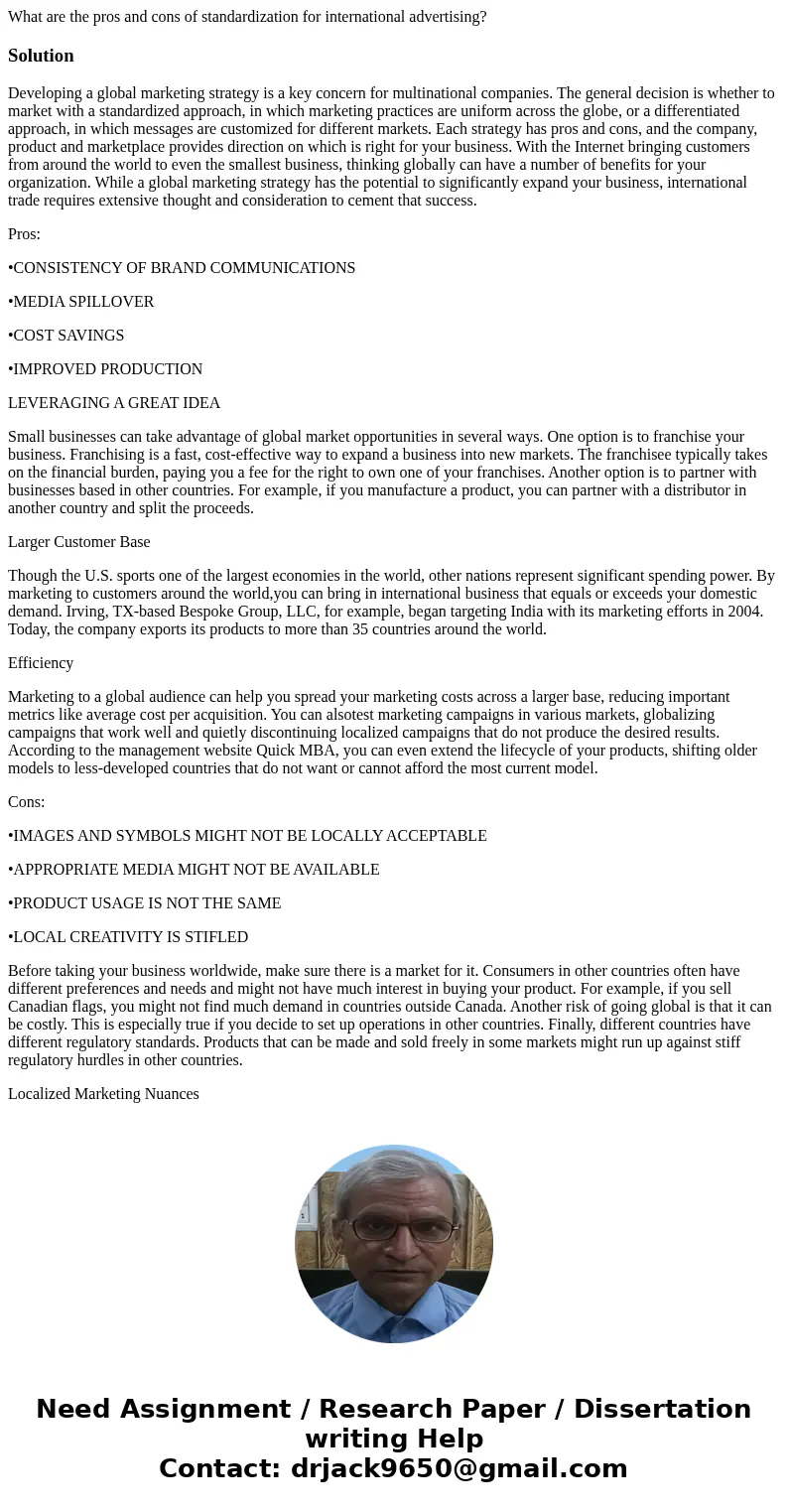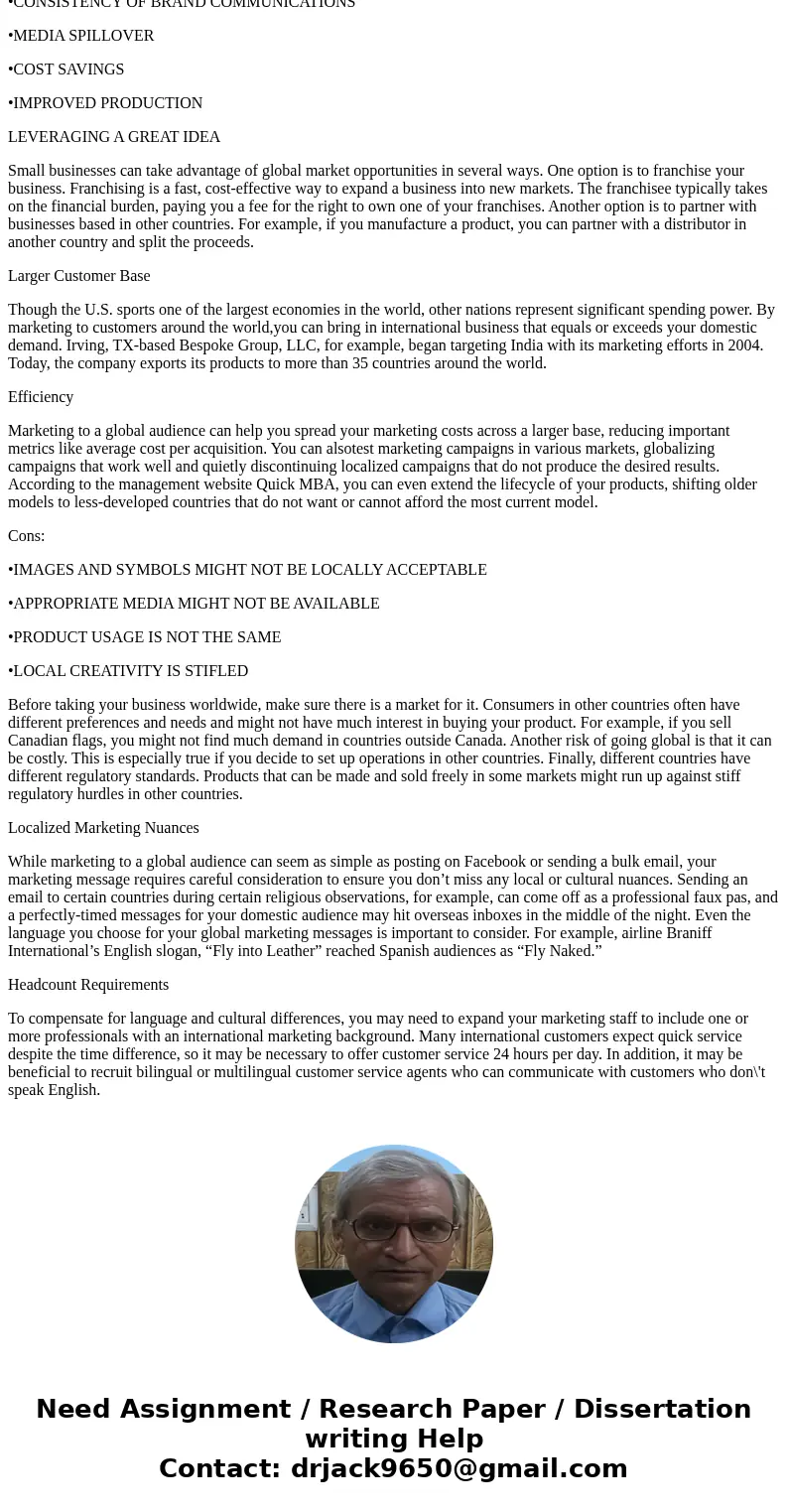What are the pros and cons of standardization for internatio
What are the pros and cons of standardization for international advertising?
Solution
Developing a global marketing strategy is a key concern for multinational companies. The general decision is whether to market with a standardized approach, in which marketing practices are uniform across the globe, or a differentiated approach, in which messages are customized for different markets. Each strategy has pros and cons, and the company, product and marketplace provides direction on which is right for your business. With the Internet bringing customers from around the world to even the smallest business, thinking globally can have a number of benefits for your organization. While a global marketing strategy has the potential to significantly expand your business, international trade requires extensive thought and consideration to cement that success.
Pros:
•CONSISTENCY OF BRAND COMMUNICATIONS
•MEDIA SPILLOVER
•COST SAVINGS
•IMPROVED PRODUCTION
LEVERAGING A GREAT IDEA
Small businesses can take advantage of global market opportunities in several ways. One option is to franchise your business. Franchising is a fast, cost-effective way to expand a business into new markets. The franchisee typically takes on the financial burden, paying you a fee for the right to own one of your franchises. Another option is to partner with businesses based in other countries. For example, if you manufacture a product, you can partner with a distributor in another country and split the proceeds.
Larger Customer Base
Though the U.S. sports one of the largest economies in the world, other nations represent significant spending power. By marketing to customers around the world,you can bring in international business that equals or exceeds your domestic demand. Irving, TX-based Bespoke Group, LLC, for example, began targeting India with its marketing efforts in 2004. Today, the company exports its products to more than 35 countries around the world.
Efficiency
Marketing to a global audience can help you spread your marketing costs across a larger base, reducing important metrics like average cost per acquisition. You can alsotest marketing campaigns in various markets, globalizing campaigns that work well and quietly discontinuing localized campaigns that do not produce the desired results. According to the management website Quick MBA, you can even extend the lifecycle of your products, shifting older models to less-developed countries that do not want or cannot afford the most current model.
Cons:
•IMAGES AND SYMBOLS MIGHT NOT BE LOCALLY ACCEPTABLE
•APPROPRIATE MEDIA MIGHT NOT BE AVAILABLE
•PRODUCT USAGE IS NOT THE SAME
•LOCAL CREATIVITY IS STIFLED
Before taking your business worldwide, make sure there is a market for it. Consumers in other countries often have different preferences and needs and might not have much interest in buying your product. For example, if you sell Canadian flags, you might not find much demand in countries outside Canada. Another risk of going global is that it can be costly. This is especially true if you decide to set up operations in other countries. Finally, different countries have different regulatory standards. Products that can be made and sold freely in some markets might run up against stiff regulatory hurdles in other countries.
Localized Marketing Nuances
While marketing to a global audience can seem as simple as posting on Facebook or sending a bulk email, your marketing message requires careful consideration to ensure you don’t miss any local or cultural nuances. Sending an email to certain countries during certain religious observations, for example, can come off as a professional faux pas, and a perfectly-timed messages for your domestic audience may hit overseas inboxes in the middle of the night. Even the language you choose for your global marketing messages is important to consider. For example, airline Braniff International’s English slogan, “Fly into Leather” reached Spanish audiences as “Fly Naked.”
Headcount Requirements
To compensate for language and cultural differences, you may need to expand your marketing staff to include one or more professionals with an international marketing background. Many international customers expect quick service despite the time difference, so it may be necessary to offer customer service 24 hours per day. In addition, it may be beneficial to recruit bilingual or multilingual customer service agents who can communicate with customers who don\'t speak English.


 Homework Sourse
Homework Sourse